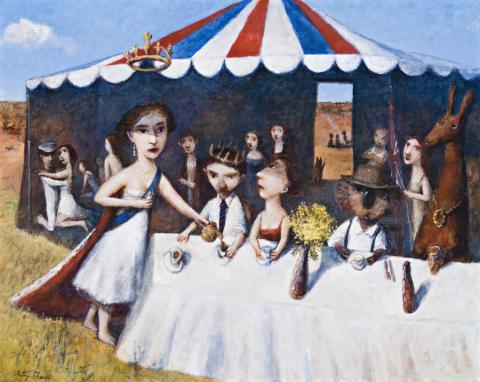THE GREAT WHITE GODDESS, 1998
GARRY SHEAD
oil on canvas
122.0 x 153.0 cm
inscribed verso with title and date
Kenthurst Gallery, Sydney
Private collection, Sydney
On 5 February 1954, when Garry Shead was just twelve years old, he was taken with other boys from his school to the Sydney showground to welcome Queen Elizabeth II. The royal visit to Sydney was the largest public event in that city's history since the opening of the Harbour Bridge almost two decades earlier, and Shead can still recall the experience more than forty years later: 'I remember seeing her and feeling the eye contact as she passed. There was something unearthly and untouchable in her beauty' She passed like an incarnate spirit'.1
Unlike his acclaimed 'Kangaroo' series which was loosely based upon the novel of the same title by D.H. Lawrence, the 'Royal Suite' paintings superbly encapsulated by The Great White Goddess do not engage a pre-existing narrative, nor do they document specific events or episodes from the royal visit. Rather, each image - dramatic and unexpected - presents a palimpsest through which one may perceive echoes of the royal progress, the republican debate, personal sexual fantasies and yearnings, as well as other biographies and autobiographies. Imbued with feelings of tenderness, melancholy and even alienation, the paintings invariably feature Bob Menzies' revered 'white goddess'2 and her royal consort moving incongruously among their subjects - koalas, kangaroos, cockatoos, emus and occasionally, the token Aborigine in full corroboree dress. Yet if the backdrop here is unmistakably the Australian outback, the identity of the two chief protagonists remains deliberately ambiguous - Prince Phillip's facial features are strikingly reminiscent of the artist, while Queen Elizabeth II bears more than a passing resemblance to Shead's own wife Judit.
With a myriad of visual clues richly interwoven in his iconography, the interpretation of paintings such as the present is thus ultimately left to the viewer, as Sasha Grishin observes, 'Garry Shead's 'Royal Suite' series invites readings on different levels. The series can be interpreted as a historical recreation of a specific royal tour in 1954 as seen through the distorting mirrors of memory and the eyes of a young boy. It is about a young and sexually desirable monarch who' floats in the air or walks on red carpet. Crowns hover over her head and her subjects, accompanied by local fauna and flora, assemble to worship her. The series can also be interpreted as an allegory, an expression of naive belief in a white goddess. One who was seen as supernatural, who could not be touched or experienced, but could only be worshipped. She came from a remote place and appeared to her subjects in the form of a celestial apparition. Simultaneously subverting this interpretation was a growing awareness of the sordid reality that surrounded her; a faithless consort and the growing impotence of imperial power. Perhaps on the simplest level, the series is about the quest for a new Holy Grail. It is a tale about the gradual process of disillusionment where realisations of reality gradually dissolve the illusions of the absurd.'3
1. Grishin, S., Garry Shead: Encounters with Royalty, Craftsman House, Sydney, 1998, pp. 11-12
2. Keneally, T., Our Republic, William Heinemann Australia, Melbourne, p. 35
3. op.cit., p. 27
VERONICA ANGELATOS
